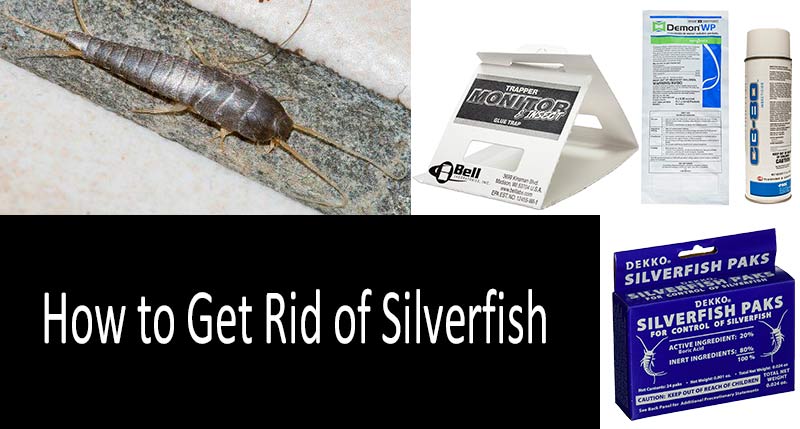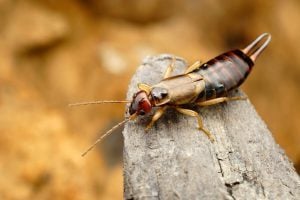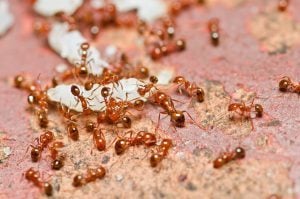Over 12 species of silverfish exist in the USA, and the most spread ones are silverfish and firebrats. They are very much alike and are almost invisible to humans. Both of them crawl out at night only, move around very fast and can hide better than James Bond. Perhaps the antagonists of this article have fun on your bookshelves or in your flour reserves while you’re reading this review. Here you’ll know how to get rid of silverfish and find 8 silverfish killers.
Table of Contents:
- How to Tell Silverfish and Firebrats Apart?
- Why are Silverfish Dangerous? Do Silverfish Bite?
- Getting Rid of Silverfish without Artificial Chemicals
- How to Get Rid of Silverfish with the Help of Modern Artificial Chemicals?
- 4 Best Silverfish Powder Killers
- Silverfish Sprays and Concentrated Liquids
- Silverfish Traps
It’s not that simple to locate their shelter. It is even more difficult to repel them from your home. That’s why many products which claim to be “silverfish killers” are poorly effective in reality. We’ll bust all of the myths which are popular online and will teach you apply proper preventive measures, use the traps and poisons for these tiny pests. We’ll base our review on the scientific data and on the reliable opinions of scientists and experts.
{code 416}
In the first part we’ll describe the behavior of these disgusting insects, will explain why they are dangerous and will cover some moderate homemade recipes and in the second one we’ll list the best ready-to-use products for effective silverfish elimination including traps and chemicals.
How to Tell Silverfish and Firebrats Apart?
Let us first say that the same traps, repellents and poisons can be used against all of these types of silverfish. You do have to be able to tell them apart though, as the silverfish’ and firebrats’ behavior and habitat differ. This influences the effectiveness of prevention measures and of non-chemical insect elimination directly. Moreover, known the fact about different silverfish behavior will help you find their nests which are usually secluded from human eye.
- By Their Appearance
At a first glance silverfish and firebrats are very similar. They have a long wingless body of a quarter to half an inch size with two antennae on the head. Both types of insects are carrot-shaped: the front of the body is thick and the back is quite thin. At the end of the carrots can be seen three tail rudiments can be seen, and on the sides there are stubby legs. The experts from the Department of Entomology University of Minnesota name the color the main external difference between the two species. Silverfish are of silvery whitish color, and firebrats have motley gray-brown bodies. However, when an insect is moving (and they are constantly running around), its color can confuse anyone.
- By Their Habitat
These insects get in the house similarly: most often they are brought inside the building together with the construction materials, recycled paper, bulk foods and other substances which silverfish love to inhabit and to feed in. Still, the Minnesotan entomologists are positive that the insects often initiate the visits themselves as they can survive starving and overcome long distances. That’s how they crawl into our houses.
Now that they’ve reached your house, what’s next? Both the silverfish and the firebrats settle in damp areas near the food. The idea is similar, but the spots of settlement are different. Silverfish prefer less hot and damp locations, they enjoy the temperature of about 70-80º F. Firebrats’ comfortable temperature is in the range of 90-120º F. The experts assure that this has a serious impact on their nesting habits. The former insects are most commonly found near bookshelves and wardrobes, in the basement and produce warehouse, barns and attics. Firebrats settle in the boilers and hot water pipes, steam tunnels and insulation materials, bakeries and regular kitchens. Both species can also be found in the bathroom and in the greenhouses.
- By Their Behavior
We can barely name any differences regarding this. The creatures consume the same things: they are attracted by high protein foods, starch or sugar food. Among their favorites there is grain flour, cloth and cellulose (any type, from the wallpaper to the books).
Both silverfish and firebrats hide from the daylight in the gaps, holes and under different objects. If you move away their shelter, they will rapidly relocate to a new home. This trail is easy to recognize as the silverfish move in spurts from one point to another. Sometimes they would freeze, but after that they would break off again, that’s why they are really difficult to catch and eliminate without preparation.
Why are Silverfish Dangerous? Do Silverfish Bite?
Neither of them can directly harm humans; don’t be afraid of silverfish bites. They will never crawl into your ear and gnaw your brain. These insects won’t be able even to bite your hair ends. Furthermore, the scientists are certain that silverfish do not spread any diseases or infections (according to the Minnesotan entomologists). What is dangerous about them, then? Is it necessary to fight them? Here is a list of the main reasons for getting rid of silverfish at your place:
- Silverfish attack books, archives and documents. The UC IPM experts unveil the secret of these creatures’ unhealthy attraction to cellulose. It turns out that their guts contain a ferment which turns it into a nutritious element. That’s why these pests attack wallpaper, books and documents. Obviously, they won’t finish a whole page, but fungus, yellow spots and blackening can appear on the spots of their bites, that is why silverfish are the libraries’ and archives’ mortal enemy.
- They defecate. These species leave their feces everywhere: on the table, in your papers, on the food. Moreover, they can lay eggs in your flour or on someone’s piece of bread. You are not likely to notice eggs and feces or feel their taste… but this is something that definitely shouldn’t be tasted!
- Silverfish breed actively. A female insect can lay 50-200 eggs at once. Little pests hatch within 2-4 weeks, and the mother will be able to lay eggs again soon. That is why a single silverfish can spawn thousands of offspring, which can be the beginning of a full-scale invasion.
- They are almost omnivorous. These insects are looking for food everywhere. They gnaw on the silk, cotton, viscose and linen clothes in the wardrobes, they then crawl on the wallpaper and finish it together with the organic glue. These insects adore human food as they can easily consume flour, macaroni, cereals, animal feed, and mushrooms. You wouldn’t want to share these products with silverfish, would you?
Getting Rid of Silverfish without Artificial Chemicals: Prevention, Half-Measures and Homemade Treatment
The experts recommend using ready-to-use strong products only if your house is substantially infested by the animals. You can deal with a couple of silverfish and firebrats in a few easy steps.
First you have to make sure that it is these creatures that attack you. You’ll be able to recognize their presence at your place by the traces their jaws leave. They are so weak, that they can’t gnaw properly and so they can only scratch. The National Park Service U.S. Department of the Interior scientists recommend that you should look for irregular hopes and jagged scrapes on the paper and clothes, which are a sign of silverfish and firebrats invasion. Moreover, they usually leave tiny dusty flakes which are transparent in the sun and are almost weightless near their feasting places. They are scarcely seen without magnifying glass, while the minuscule black feces are visible with the bare eye, assure the experts. Successful use of adhesive tape and special traps placed near the parasites’ possible habitat will be a more persuasive proof. The small insects trapped not only will indicate the epicenters of the invasion, but will also help you identify the specific type which attacked you.
Are you convinced of being attacked by certain silverfish and firebrats? Here are the tips on eliminating them devised by the Entomology Department of the University of Minnesota.
- First thing first, check the basements, built-in closets, storage places and bookshelves. Locate trial adhesive tape traps there if you won’t actually see any insects. Finding the source of invasion is to be your primary goal. By the way, don’t bother looking for them in the sewage and vertical pipes. Despite the myths, silverfish don’t come from sewage. Their feet aren’t designed for overcoming vertical obstacles, that’s why a bath or a glass jar can become a death trap for them.
- Silverfish and firebrats are looking for places which are at least 75% damp. That’s why you should control the rooms’ microclimate carefully. Sometimes a simple ventilation or turning on the AC can help get rid of the insects and exile them from their nest. Make sure you dry any leaks under bath and old pipes, and never leave any puddles or wetness. Seal your concrete walls and get rid of the cracks in the floor. If you are thinking of doing repairs in the bathroom, install warm electric flooring and so that no silverfish can infest your bathroom.
- Cut the insects off from food. This isn’t that simple to do, but you can manage to keep the papers in separate containers and to keep the flour and grains in sealed containers. Even banal cleaning at home will substantially affect the small pests’ food habits. For example, you can occasionally throw out old paper piles, which serve as a hotel for the silverfish.
- Use simple traps. The National Park Service U.S. Department of the Interior experts share one of their experiments: “Two kinds of traps have been used to confirm the presence of silverfish. The first uses a small jar coated with flour on the inside and tape on the outside to provide a climbing surface. Jars should be placed in areas of suspected silverfish infestations and regularly inspected for silverfish, which will climb in the jar and become trapped. Conventional sticky traps such as those used for monitoring cockroach populations can also be used for detecting silverfish”
Many of these tips will be useful to you when you will completely lose sight of the insects. That’s when then the time of preventive measures comes. They include struggling with moisture and ensuring healthy air circulation in the apartment. The experts, for example, do not advise to put the boxes and containers too close to each other in the basement or barns. The same story is true for the furniture that stands too close to the walls. The silverfish and firebrats should have no place to play hide and seek.
We also recommend to those who do things around the house to carefully use a sealer on the pipes and holes, cracks and wiring and other places. Then, these ever-hungry insects won’t get into the house from the outside.
How to Get Rid of Silverfish with the Help of Modern Artificial Chemicals? Do They Work or Not? The True Facts and Myths Busted by the Scientists
If you have reached the stage of a full-scale silverfish infestation and are sick and tired of seeing them at home all the time, then it’s time to use a more effective weapon. Many people mistakenly believe that the all-purpose insecticides in any form are effective against silverfish. But this is a well-established myth and misconception! As the University of California scientists claim that “hundreds of commercially available insecticides list firebrats and silverfish on their labels. However, most of these products haven’t been adequately tested”.
The experts don’t advising using sprays and aerosols exclusively against the silverfish. They may be effective, but only when they come in contact with the insects. Since the pests’ diet consists mainly of dry matter, the UC IPM experts advise relying on loose dusts and dry poison. However, they will also be useless if they get on the moist areas, as the silverfish show less interest to sticky dust particles.
When is it time to use sprays and aerosols? It’s time when you know the specific habitat of insects and are ready to intensely spray them with such chemicals! Use the sprays containing synergized pyrethrin and pyrethroids such as bifenthrin, cyfluthrin, tetramethrin, and phenothrin. The IPM experts are positive that they will also provide for the residual activity.
As for the powders, the scientists note the ineffectiveness of boric acid. But the products containing silica gel and pyrethrin (e.g. Drione) and diatomaceous earth (e.g. Perma-Guard), on the other hand, work excellently.
University of Minnesota lists permethrin, deltamethrin, cyfluthrin, and cypermethrin as the deadliest for silverfish spray ingredients.
All of these artificial are to be used in strict accordance with the rules described by the Minnesotan entomologists:
- Do not use dry insecticides within the area of children’ and pets’ access.
- Examine carefully the label and the manual of each new product.
- It is better to fill the cracks and gaps with the dusts, rather than to throw them in the open space.
- If you trust the oil-based sprays, use them near flame and intense heat which is loved by the firebrats under no circumstances.
- Repeated treatment is carried out after 2-3 weeks, if the insects have not yet disappeared from your place. In this case, you need to take a closer look and check whether you could miss their possible nests in the most secluded corners.
Interestingly, the scientists have unanimously noted low effectiveness of silverfish baits. That, at least, concerns the baits containing boric acid, hydramethynon, and indoxacarb as the scientists from the NCBI call them “relatively ineffective”. The chance of these or other baits attracting the insect is very small. But, as some of the reviews of the control products prove, this chance still exists.
4 Best Silverfish Powder Killers
We’ll begin with an overview of powders containing powerful active ingredients. Then we’ll study the fastest way to kill them with sprays and liquids. Finally, we’ll end the review with a trap overview.
Demon Wp – Envelope (4 of 9.5g Packets) -1 Envelopes

Сypermethrin, a synthetic peritroid and a twin of the chemicals recommended by the experts, is used as an active ingredient here. The sellers claim that this dust can be used both indoors and outdoors and that it’s advisable to shake the packet before use. They honestly don’t advise treating the area with it near dark furniture, as it can leave stains.
{code 957}
Price: Check current price
Safer Brand 51703 Diatomaceous Earth Bed Bug, Flea and Ant Crawling Insect Killer, 4 lb

This is a very simple universal product with no toxic effect, and it is suitable for cockroaches, ants, crickets, centipedes and earwigs. It seems like it can be used even on beds, mattresses, kitchens and living rooms … But will Safer Brand kill firebrats and silverfish?
The information on the influence of Safer Brand DE on silverfish and firebrats is different. Some customers note a considerable decline in its populations. Others complain of poor effectiveness of the powder. The negative and positive comments are split almost evenly. Obviously, this dust still attracts bugs, but perhaps it does not seem too delicious for them…
We still recommend this product to the readers, all the more so this substance can do barely any harm to people. Of course, you should keep it away from kids and it’s probably not the best idea to season your meals with it, but it contains no actual poison. The only thing a couple of people in the comments section complained of was a slight skin irritation after coming in contact with the product constantly. Though, it’s hard to imagine what they were doing with the powder, perhaps, they rubbed it in?
{code 958}
Price: Check current price
Dekko Silverfish Paks DEK1002 (Pack of 2)

The manual states that you’re supposed to place 2-3 packets near each infestation epicenter. As for the attics and basements, you can flood them with the sachets. You’ll see considerable changes in the population of the parasites within 3 days to 4 weeks from unpacking the product.
The main competitive advantage of Dekko Silverfish Paks is that it was specifically adapted for our review’s antagonists. This can be observed even by the people’s reaction to the product. In the comments section, the customers share their ideas on perfect placement of the sachets. They put them in the bathrooms, in the shower and in the ventilation shafts. It’s better not to put the papers near the food, as this is a poison after all. It is also dangerous for pets, although they are usually not very interested in cellulose.
Above we have quoted the opinions of scientists about the relative ineffectiveness of boric acid against silverfish and firebrats, but perhaps this is the case, when the opinions of real users will be much more convincing as 77% of buyers appreciated the Dekko product. This is a good, but not a very universal treatment.
{code 959}
Price: Check current price
3 Pk, Boric Acid Roach & Ant Killer NET Wt. 1 Lb. (454 gms) Each
 This is a classic dry boric acid powder, which costs more reasonably that the previous one, and it is easier to fill in cracks and holes with it. This product costs Check current price (3-pack) and it is sold almost better than all the other participants of our ranking. However, it cannot be called special as the Boric Acid Roach & Ant Killer is popular in the Ants & Cockroaches Control section. However, this substance is also capable of dealing with silverfish.
This is a classic dry boric acid powder, which costs more reasonably that the previous one, and it is easier to fill in cracks and holes with it. This product costs Check current price (3-pack) and it is sold almost better than all the other participants of our ranking. However, it cannot be called special as the Boric Acid Roach & Ant Killer is popular in the Ants & Cockroaches Control section. However, this substance is also capable of dealing with silverfish.
Price: (3-pack) Check current price
The insecticide powders are rather effective, but their action is not immediate. For those who don’t want to and cannot wait for the silverfish to leave their house, we have prepared the following section.
The Best Silverfish Chemical Sprays and Concentrated Liquids
Cyzmic CS (Compare to Demand CS)- 8 oz. 78938

According to the product description, it is capable of eliminating all of the insects existing in the USA. The list of potential Cyzmic CS’ victims takes up several paragraphs. The customers state that it acts best against garden pests.
As for the silverfish, the consumers rate Cyzmic higher than boric acid. They claim that the sprays are to be renewed occasionally, although the treatment is successful within a fortnight after first use.
Those who eliminate hornets left dissatisfied comments. The remaining 89% of the users have rated the product’s merits highly.
{code 960}
Price: Check current price
CB-80 Contact Aerosol 17 oz, 1 Can

{code 961}
Price: Check current price
Finally we would like to suggest to you several classic adhesive traps against silverfish and firebrats. It’s better to use them as a supplementary measure of insect control along with powerful artificial chemicals and preventive measures. Moreover, sticky traps are a great means of monitoring the amount of pests remaining.
The Best Silverfish Traps
Trapper Insect Trap (Great for Bed Bugs, Spiders, Cockroaches) – Includes 90 Traps

All the boxes are formed in blocks of three cells (7x 3 inches each), and you can place them around the house in this way or you can divide them into very small traps. The first format is suitable for killing cockroaches, and the second is just perfect against silverfish.
What is convenient is that there is special room for recording the date and the time of placing the cardboards right on the actual Trapper Insect Traps. This will make it easier for you to track the results of your activity and to remember to change the traps in time after the sticky tape dries out. With the help of a small glue stripe at the bottom, these triangles can be fixed basically anywhere.
If located correctly, the Trapper Insect Traps are highly effective against our bugs. The customers specify that you can catch silverfish “in bulk” with it, as the more cells you place, the more insects you trap.
{code 962}
Price: (90-pack) Check current price
Trapper Max Glue Traps 12 Glue Boards Trap Mouse Bugs Insects Bed Bugs Spiders Cockroaches NON-TOXIC
This product is very similar to the last one, but it is not divided into smaller cells. Its competitive advantage is it coverage area of 4.5×6.5 inches (this is the sticky area only; the gross area is 5.5×7.5 inches). Moreover, it is transformable as the cardboard can be rolled. This doesn’t matter much for the silverfish case, though.
A single pack of Trapper Max Glue Traps contains 12 strips. This is an entire runway for hundreds of pests. Their death won’t be very human, but it will most certainly happen! In any case, there are confirmations of effectiveness of this product against silverfish and firebrats in the comments. The overall rating of these sticky traps is a bit lower than that of the previous items.
As for small drawbacks, mice, useful insects and even tiny puppies can get stuck on the strips. However, if the trap is properly used (make sure you place the cardboard correctly), this doesn’t become a problem.
{code 963}
Price: (12-pack) Check current price
Best Silverfish Powders, Sprays and Traps Comparative Chart
| Product | Type | Active Ingredient | Best Use |
| Demon Wp | Powder Killer. | Cypermethrin. | Spray in pests’ activity spots; be careful with dark surfaces as it can leave traces on them. |
| Safer Brand 51703 | Powder Killer. | Diatomaceous Earth – 100% natural killer. | Spray in pests’ activity spots, for indoor use only. It is safe to use near pets and kids. |
| Dekko Silverfish Paks | Powder Killer. | Boric Acid. | Place 2-3 packets near each infestation epicenter. |
| 3 Pk, Boric Acid Roach & Ant Killer
|
Powder Killer. | Boric Acid. | Spray in pests’ activity spots, for indoor use only. |
| Cyzmic CS | Concentrated Insecticide. | Lambda-Cyhalothrin. | Dissolve in water according to the manual and spray in places of silverfish abundance. Be cautious when using it indoors, always wear protective gloves and mask. |
| CB-80 Contact Aerosol | Aerosol Spray. | Pyrethrin. | Spray over the insects, kills on contact. |
| Trapper Insect Trap | Sticky Traps. | Place as many traps as you can where you’ve seen these insects. Use it everywhere you need. | |
| Trapper MAX Glue Traps | Sticky Traps | Place as many traps as you can where you’ve seen these insects. Use it everywhere you need. |
Summarizing!
Don’t panic if your house is infested with silverfish. The experts have long devised an algorithm of their elimination. First, identify their location, then clean up the house, and resort to sprays, powders and traps in extreme cases (luckily, the market offers a wide range of products to choose from). The main thing is not to forget about prevention measures with regards to these nasty insects. If you carry them out, the pests won’t ever bother you again.
{code 416}
{code 112}









